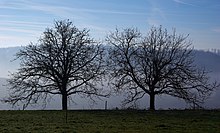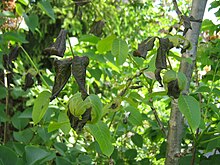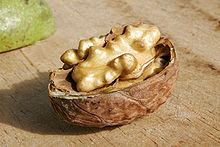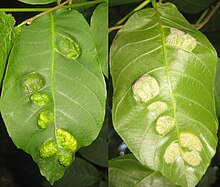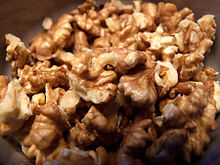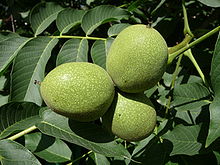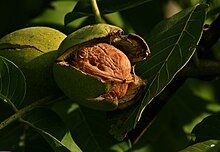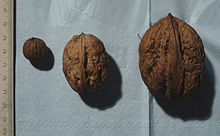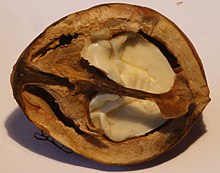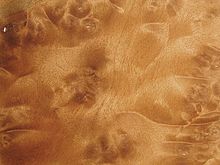Real walnut
| Real walnut | ||||||||||||
|---|---|---|---|---|---|---|---|---|---|---|---|---|

Real walnut ( Juglans regia ), illustration |
||||||||||||
| Systematics | ||||||||||||
|
||||||||||||
| Scientific name | ||||||||||||
| Juglans regia | ||||||||||||
| L. |
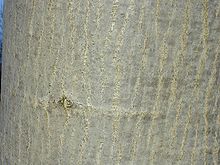
The real walnut or the walnut ( Juglans regia ) is a deciduous deciduous tree from the walnut family (Juglandaceae). Most colloquially it is called simply walnut tree or walnut , regionally also Welschnuss (Austria) or tree nut (which is also the Swiss or old Alemannic name of the fruit). In English it is called Persian Walnut , from Old English walhnutu ( wealh + hnutu , "foreign nut"), hence the German occasional Persian walnut , Danish Valnød , Swedish Valnöt .
The name " Walnuss " (from Middle High German welsch nuz ) of the fruit of Juglans regia originally means " welsche (ie" coming from the Romans ") nut", as it came into German via France or Italy . Its fruits are the well-known walnuts. The walnut wood is considered to be the most sought-after and valuable of the Central European forest.
description
The walnut tree reaches heights of 15 to 25 m, and in denser tree populations up to 30 m. Its height growth ends at around 60 to 80 years. It can reach an age of 150 to 160 years. The tree forms a deep-rooted stake-heart-root system and a broad crown in the open . Its bark is smooth and ash-gray when young, and with age a deeply fissured, dark to black-gray bark develops.
The alternate leaves are unpinnate with 5 to 9 (mostly 7) leaflets and reach a length of up to 40 cm. The dark green leaflets themselves are 6 to 15 cm long and 2 to 6 cm wide and opposite. Their shape is elliptical to ovoid, they are almost entire and hairless except for the underarm beard. In spring, the walnut is the last deciduous tree to turn green after the oak ; she throws it off early in autumn. The leaves give off an aromatic scent when rubbed.
The real walnut is monoecious ( monoecious ) and heterodichogamous , so there are female and male flowers on one plant. The male flowers are too many in pendent, male inflorescences ( catkins ), the female flowers in little-flowered inflorescences. Flowering takes place between April and June, with the male flowers usually appearing four weeks earlier ( proterandry ). Pollination takes place by wind ( anemophilia ). The greenish-yellow colored male flowers sit in an inflorescence that has the shape of a hanging kitten. These are quite noticeable as thick, cylindrical inflorescences. They are six to twelve centimeters long and develop from the axillary buds of the previous year's leaves. A single male flower consists of 3–6 tepals , two bracts and a bract . These envelop the inner, up to 30–40 stamens . The female flowers have an inconspicuous four-part perigone with two conspicuous, feathery stigma lobes on a short stylus and 2 to 5 of them appear in vertical spikes at the ends of this year's shoots. The two-part stylus is used to bring the two scar flaps into the correct position for fertilization. The scars are initially shiny green and then reddish in color. The flowers reach a length of approx. 10 to 15 mm and a width of 5 to 10 mm. The underlying, two-leaved ovary is fused with the perigone and with bracts and bracts which initially form a hairy shell. Flowering occurs for the first time between the ages of 15–20. 4 to 6 cm in size, ellipsoidal to rounded fruits are formed. The fruit shell is fleshy and fibrous, cracks open when ripe and releases the wrinkled, light brownish core ( endocarp ). The light brown pericarp is heavily lignified and shallowly furrowed and consists of two intergrown halves.
The fruits and their kernels are known as "walnuts" and are used as food. Traditionally, the fruits of the walnut family were in Botany as drupes . However, recent studies show that they belong to the nut fruits group . Contrary to earlier opinions, the green shell surrounding the nuts is not part of the pericarp, but is formed from leaf organs. The nut itself varies greatly in shape and size. It can be round, oval, cylindrical, egg-shaped or beak-shaped, is 2.5 to 8 cm long and 2.5 to 5 cm wide. The shell thickness is 1.8 to 2.2 mm. The embryo has large, bulging, furrowed cotyledons . The ovarian cavity is quadruple in cross section due to an incomplete, false and a real septum. The real septum is created by the syncarpic fusion of two carpels, whereby the ovary is divided into two compartments. Due to the incompletely formed, false septum, the ovary cavity appears fourfold.
The number of chromosomes is 2n = 32.
Taxonomy
The walnut family (Juglandaceae) comprises eight genera with around 60 species, including mostly trees and only a few shrubs. The real walnut ( Juglans regia ) belongs to the genus of walnuts ( Juglans ) with over 20 other species . Other well-known representatives of this genus are the black walnut ( Juglans nigra ) and the butternut ( Juglans cinerea ), which were imported to Germany from North America. Like the related species, the real walnut is genetically very variable. In Asia, for example, subspecies have been described in isolated cases , but they have not yet been generally recognized.
Due to the great intraspecific heterogeneity, numerous varieties and cultivars are also described, which differ phenologically, particularly in terms of growth behavior and the appearance of the fruits. The best known in China are the Yanbian walnut because of its good yields and the Xinjiang walnut, which is said to be highly resistant to diseases. Numerous varieties are also distinguished in artificial cultivation . In Germany alone there are over 100 varieties in the German nut catalog, which differ in nut shape, yield, frost resistance or other properties.
distribution
The real walnut is already occupied for the tertiary . It is believed that it survived the ice ages in Syria and western and southern Anatolia . Their natural range in the Quaternary it has in the eastern Mediterranean region , on the Balkan Peninsula as well as in front and Central Asia . It can be found in the humid canyon forests of the mountains and grows in the Himalayas at heights of up to 3300 m.
The walnut forests in Kyrgyzstan in the Tianshan Mountains are known. With only 4% forest area, Kyrgyzstan is one of the least forested countries in Asia, but it is home to the largest stocks of walnut trees in the world. In an altitude zone of 1000 to 2000 m, the trees, especially on northern slopes, grow up to 30 m high and reach an age of up to 150 years. Various pome and stone fruit species grow in the middle class of these forests ; the stocks are used for agroforestry .
There are a few controversial references to the spread of the species to Central Europe in prehistory; it was certainly cultivated in large parts of southern , western and central Europe since Roman times . Their current distribution is strongly influenced by the cultivation as a fruit tree. In Central Europe it is usually found in cultivated form on farms, in gardens or as a single tree in the field. Occasionally they are found wild, especially in alluvial forests of the Rhine and Danube . It thrives in Central Europe in the Querco-Ulmetum aius of the Alno-Ulmion association and in the Aceri-Tiliertum from the Tilio-Acerion association . In Upper Austria , in the alluvial forests of the Alm , Enns and Traun rivers , small-fruited, rather frost-hardy wild forms can be found. These are called pointed, beaked or corozoids. It is not clear whether this is an autochthonous Central European variety. Although the real walnut can be found in the Alps up to around 1200 m, it rarely grows in locations above 800 m above sea level. The real walnut is also grown extensively in North America because of its tasty fruits, especially in California .
Since it is very sensitive to winter cold and late frosts, it is often found in mild winter locations that are not too low in precipitation, such as in the wine-growing regions . It grows particularly well on deep, fresh, nutrient-rich and lime-rich loam and clay soils .
Despite the high-quality wood, there has hardly been any additional distribution as a forestry commercial tree , as the real walnut is considered a weak competitive light tree (but shade-tolerant in its youth) and can therefore only be integrated into common silviculture concepts to a limited extent . However, the first steps towards cultivating suitable plant material and attempts at silvicultural treatment have been initiated in recent years.
In addition, according to the “ Tree of the Year ” board of trustees, the number of walnuts has declined sharply in Germany in recent years due to excessive use and insufficient replanting, which is why it was voted “Tree of the Year 2008”.
A national nut variety garden is being built in Wermatswil near Uster in Switzerland. The Turkish town of Adilcevaz is known for its walnuts.
Economical meaning
production
In 2018, according to the food and agriculture organization FAO, around 3.7 million tons of walnuts (with their shell) were harvested worldwide.
The following table gives an overview of the ten largest producers of walnuts worldwide, who produced a total of 91.6% of the harvest.
| rank | country | Quantity (in t ) |
|---|---|---|
| 1 |
|
1,586,367 |
| 2 |
|
613.260 |
| 3 |
|
409,562 |
| 4th |
|
215,000 |
| 5 |
|
159,535 |
| 6th |
|
127.190 |
| 7th |
|
83,835 |
| 8th |
|
56.053 |
| 9 |
|
37,347 |
| 10 |
|
35,484 |
| world | 3,662,507 |
trade
The largest exporters in 2017 were the USA (139,269 t), Chile (56,499 t) and France (26,370 t).
use
Special properties
The tree reacts very variably to pruning measures on different dates. If you cut in the spring, a strong and long-lasting flow of sap occurs (often described as "bleeding to death"). It cannot be stopped with aids, but ends by itself after a long period of time due to wound healing. In order to avoid excessive bleeding of the trees, pruning measures can also be carried out in late summer (at the same time as the sweet cherry harvest), where the wound healing begins much faster.
The ground under walnut trees is usually not overgrown, existing under plants wither more than the shading would be responsible. The tree releases the inhibitor cinnamic acid by rinsing the leaves, which prevents other higher plants from thriving in competition for the nutrients. Such a biochemical defense is called allelopathy . A glucoside is formed in the green organs, which is converted into juglone after it has been released, for example by breaking down the fallen leaves on the ground . Juglone has a germ and growth inhibiting effect on numerous plant species. The leaves of the walnut tree are particularly rich in tannin , they degrade more slowly than other leaves and are also avoided by most insects. Nut trees are also attributed the ability to drive away flies, so they were often planted in farms (next to the dung heap).
The real walnut is grown primarily because of the fruit yield. But since wood is also in great demand, attempts have been made to use the tree for forestry since the end of the last century. The varieties offered in the trade are usually selected for a high fruit yield. Many trees are therefore also offered as half-trunks . The leaves are also dried and processed for external and internal use.
Forestry use requires fast-growing and straight-growing plants, which are not currently on the market. Growing in stands narrows the crowns, which leads to a lower fruit yield, but also to longer, knot-free trunk sections. Trees growing under competition can grow up to 10 m taller than individual trees. In connection with the production of valuable wood, the walnut ( ![]() ) was crossed with the black nut (
) was crossed with the black nut ( ![]() ). The resulting Juglans × intermedia is said to be crowned and fast-growing. One expects a higher frost hardness than with the walnut and a resistance against the black nut death .
). The resulting Juglans × intermedia is said to be crowned and fast-growing. One expects a higher frost hardness than with the walnut and a resistance against the black nut death .
Pests
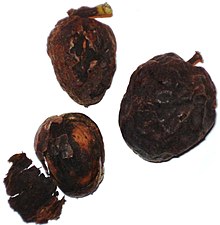

The walnut fruit fly ( Rhagoletis completa ), which originated as a neozoon from North America , has been spreading in Europe since the late 1980s . Their egg-laying in the shell of the unripe fruits causes them to rot and turn black; when dried, the pulp cannot be removed from the nut or is only very difficult to remove.
In rainy years with few peaks in between, the plants do not have enough time to dry off, which benefits the leaf spot fungus ( Gnomonia leptostyla , Marssonina juglandis ). In consistently wet weather - as in 2010 - the fungus can destroy large parts of the harvest.
The leaves are also attacked by a mite . The walnut felt-gall mite ( Aceria erinea , order Trombidiformes ) colonizes the underside of the leaves and causes felt-like growths and light green bulges on the leaf surface.
fruit
Nut yield per year per tree
| Age | Good location |
Bad location |
|---|---|---|
| 1–15 y. | - | - |
| 16-25 y. | 10 kg | 7 kg |
| 26-35 y. | 25 kg | 15 kg |
| 36-60 y. | 45 kg | 22 kg |
| 61-80 y. | 55 kg | 13 kg |
| 81-100 y. | 32 kg | 13 kg |
Walnut trees begin to bear fruit from the age of 10 to 20 years. Good yields are only achieved from the fourth decade onwards, which then decline again in old age. In addition to age, the yield depends on the location and the variety. The trees do not fruit equally well every year, the weather plays an important role. It is said that good nut years are also good wine years. It is assumed that for a good year there will be two medium harvests and one bad harvest. With a good harvest, large-crowned trees can produce a maximum of 150 kg of nuts per tree.
The fruits ripen into walnuts in Central Europe in late September to early October . In California, the harvest lasts from late August to November. They are ripe when the green, fleshy coating pops open, causing the nuts to peel off the shell and begin to fall to the ground. Usually the nuts are shaken from the trees, swept in rows, picked up and brought to the first cleaning and subsequent drying. The remains of the outer shell are removed from them, washed and sorted out on the belt. They must then be stored in an airy and dry place to prevent mold infestation . In larger warehouses, the nuts are turned several times during the drying process for a few days. Air-permeable nets are suitable for drying smaller quantities. During drying, the moisture content is reduced to a maximum of eight percent and thus the weight of the nuts by up to 50 percent. Then the nuts are actually processed, where they are first disinfected through fumigation . The processing and quality is regulated by the United States Department of Agriculture (with controls by the FDA ) and the European Union marketing standard. Since well-dried nuts can be stored for several months, they are available all year round. Nuts to be sold unpeeled to end users are first sorted by machine by size, empty nuts are vacuumed off, then sorted by hand. Finally, they are optionally brushed off, washed or sulphurized and bleached (with sodium hypochlorite or hydrogen peroxide ) to increase their sales value.
To make peeling easier, the closed nuts are sorted by core size. Special cracking machines , so-called dragon crackers , break open the shell and separate the components from each other. Light shell parts and small core parts are blown out and sieved according to size. The goods are then scanned with a laser on a belt and the shell parts are sorted out with the aid of individually controllable compressed air nozzles. After the laser sorting system has been run through several times, workers are finally inspected. The common walnut is by far the most common in trade. The black nut is a small variant of the common walnut. Other varieties are the hard-shelled flail nut with a length of 6.5 cm and a diameter of 2.6 cm and the tit nut with a very fragile shell. The soft shells of horse nut are traditionally made into small jewelry boxes. Therefore they have the French name noix à bijoux ("nuts for jewels").
kitchen
The walnut is used in many dishes, from cakes to walnut ice cream. In addition to whole nuts, walnut kernels and walnut oil that have been removed from the shell are also sold, as well as brittle for decorating desserts. Walnuts are also used for Waldorf salad , tortelloni , Skordalia , Kozunak , Lobio , Nunt or as a Tschurtschchela .
Another option is to harvest semi-ripe green nuts in June ( carob nuts ). These can be used to make preserving fruit with a high vitamin C content (also called candied black nuts ) or a nut liqueur (nut spirit, nut schnapps). In Italy, the still green nuts, which are traditionally harvested on Midsummer Day, are used to make a special liqueur, the nocino . In Serbia , Croatia and Bosnia and Herzegovina , a liqueur is made from the still green nuts, the Orahovac .
Health benefits
Depending on whether fresh or dried, walnut kernels have a fat content of 42 to 62.5 percent, 11 to 16 percent protein and 15 to 23 percent carbohydrates. Of all nut fruits, walnuts have the highest linolenic acid (an omega-3 fatty acid ) content, at 7490 mg / 100 g . They are also rich in tocopherols , a group of four different forms of vitamin E. In addition, this fruit is rich in zinc and potassium , it also contains magnesium , phosphorus , sulfur , iron , calcium and vitamins A, B 1 , B 2 , B 3 , C and pantothenic acid . The calorific value of 100 g of consumable portion is 2738 kJ. A comparison of the calorific values and fat content of nuts can be found under nuts .
In a study on Mediterranean diets, it was found that the nuts have a protective effect against diabetes (type 2) . Recent studies also show that as little as nine walnuts a day and a teaspoon of walnut oil can protect the body from high blood pressure in stressful situations. In combination with linseed oil , walnuts should also have a positive effect on the condition of the blood vessels . In addition, walnuts appear not only to counteract cardiovascular disease , but also to curb prostate cancer .
Recent studies have put polyphenols in the foreground. These substances are considered to be effective radical scavengers . They protect the body from oxidative stress caused by chemically aggressive substances. The walnut contains around 15 to 25 milligrams of polyphenols per gram. Because of its antioxidant properties, researchers believe that walnuts can slow the progression of degenerative brain diseases such as dementia and Parkinson's . So far, however, this theory has only been supported by experiments on mice.
The dried pinnate leaves ( Folia Juglandis ) and the fresh, green fruit peels (Cortex Juglandis nucum) are used as medicinal drugs. Folia Juglandis is official . Both pinnate leaves and fruit peels contain plenty of tannins ( ellagitannins ), flavonoids , phenolic carboxylic acids, vitamin C and small amounts of essential oils. Preparations from the leaves are used externally as an astringent for baths, rinses and compresses for skin ailments such as acne , eczema , scrofula and against excessive perspiration . Especially the fruit peels contain naphthoquinone derivatives such as juglone and hydrojuglon . According to Madaus , the walnut is repeatedly recommended for scrofula , also for bone damage, inflammation or a tendency to bleed, also as a brush for chronic tonsil swelling, against gout , diabetes , chronic eczema and to inhibit perspiration. According to Madaus, Dioskurides already mentioned that the nuts would cause headaches, but help against poison arrows , tapeworms and the "bite of the mad dog". When used as a pomade, the peel rubbed in wine and oil produces beautiful hair for children.
Half-ripe nuts and leaves harvested in early summer contain up to 1 percent vitamin C and are among the most vitamin C-rich parts of plants in Central Europe. They have been used in a variety of medical fields since ancient times. Its extracts are still used in naturopathy today and are said to help with anemia , diabetes mellitus , diarrhea , intestinal parasites , chilblains , skin ulcers and wounds . They are said to have an antiseptic, worming, tonic, blood-cleansing and scarring effect.
Wood

The wood of the real walnut is a sought-after precious wood , the use of which is limited to high-quality objects. As a rule, it comes from former fruit trees, as the specific cultivation of walnuts for wood production is only rudimentary. Nut trees are not felled like other tree species, but are dug up with the rootstock. The lowest parts of the trunk, so-called burl bulbs, of walnut trees, which are often formed at refinement points by the grafted stems, are the most valuable trunk sections for the production of veneers . They provide fine geaugte valuable burl veneers for furniture and lately as interior in luxury automobiles. Furthermore, pyramid veneer is made from forked branches. A widespread mistake, however, is that the roots of the walnut would also provide such grain veneer - their wood is almost completely structureless, light in one color and therefore not very decorative and practically worthless. There is probably a confusion between the terms grain veneer and root veneer , which means two completely different types of wood. The wood is also particularly popular for the production of clock cases, musical instruments, parquet, choir stalls in sacred buildings, chess pieces and other woodturned and carved goods. Walnut wood became a substitute for tropical wood due to its excellent physical and aesthetic properties. The preferred use for rifle stocks is also known. Here it is considered the most suitable type of wood because of its high dynamic strength and its low tendency to splinter. This use contributed significantly to the depletion of the population in times of war.
The typical heartwood has a gray-white to reddish-white sapwood and a dark-colored core. This is very variable in color and can be gray to dark brown. The color variations often depend on the location, in particular on the factors of climate and soil conditions. In trade, a distinction is made between origins. Compared to German and Swiss origins , Italian walnut has a more reddish color and a livelier structure. In Germany around 70 years ago, the Caucasian walnut with its black color was particularly popular, today the drawing and coloring of French walnut is appreciated .
The wood is semi-ring pored . This means that the early wood with its larger vessels separates itself from the small-vessel late wood , but not as clearly as in ring-pored wood. This results in a decorative flattening of the cut surfaces in the case of tangential cuts and a striation in the case of radial cuts. In addition, the color of the core is often streaky or cloudy, or the grain deviates from the trunk axis. This results in flamed, bolted or grained surfaces that fetch special prices in the timber trade. Walnut is fine-grained, medium-hard and medium-heavy. The bulk density ρ 0 is 640 kg / m 3 (450–750). The wood is tough and flexible, but not very elastic. It is permanent even in damp conditions and can be easily worked, stained and polished . When fresh fades it strong, but good dimensional stability after air drying. John Williams ' novels mention walnut furniture in noble villas several times.
Due to the scarcity of real walnut wood, there are many woods on the market that look superficially similar to walnut wood, some of which are also marketed under the misleading name “nut” or walnut . These include: "African walnut" or "African walnut" (for Dibétou ; Lovoa trichilioides ), "viola nut" or "African black walnut" (for Mansonia; Mansonia altissima ), jasper nut (for Mutenye; Guibourtia arnoldiana ), Tanganyika nut (for Aningré Blanc; Pouteria altissima (Syn .: Aningeria altissima )), "New Guinea Walnut" (for Paldao; Dracontomelon dao ), or "Satin nut" (for Sweet Gum; Liquidambar styraciflua ).
Other uses
The extract produced from the green coating of the nuts is suitable as a coloring agent for wood in the form of nut stain or as a tanning agent. The wrapping has also been used as a brown textile dye since Roman times. The ingredient juglone is responsible for this . The walnut bark is also suitable as a staining and coloring agent. In addition, it is also used in the brandy industry as an aging agent or additive to achieve a desired type of brandy ( typage ). Preparations made from the fruit peel are also popular for coloring skin and hair brown. Since the content of juglone is not known in detail and this compound has been found to have cell-damaging properties, regular use is not recommended.
Ground walnut shells are sometimes used in the form of granules as blasting agents for surface treatments. In this way, gentle cleaning of less soiled, sensitive surfaces (for example, non-ferrous metal , rubber tools or electrical parts) can be achieved. Another possible use is the restoration of wooden works of art, where the irradiation removes paint residues and recovers an open-pored wood structure. Finely granulated, they are also used as cleaning agents in hand washing pastes.
Symbolism and popular belief
In terms of the doctrine of signatures , similarities between the walnut and the genitals or the cerebrum were seen. This can perhaps be seen as a motif in fairy tales such as Grimm's Allerleirauh , De Zwei Künigeskinner , The Iron Oven or, in Bechstein's case, The Nusszweiglein , The Three Nuts . Also in Clemens Brentano's story Three Walnuts it comes to walnuts.
Marianne Beuchert has compiled information about walnuts in the book Symbolik der Pflanzen . Nuts are generally considered a symbol of fertility. The walnut played an important role in Roman wedding customs. The groom threw these among guests and spectators. A bright sound on impact should predict a marriage as happy as that of Jupiter and Juno . The Teutons, who adopted the custom from the Romans, consecrated the nuts to Fro , the goddess of love and the blessing of the harvest, but mixed the precious walnuts with hazelnuts. From Roman times walnut shells in graves and during burnt offerings are documented for today's southwest Germany, today's Switzerland and parts of today's France .
There are different meanings in Christianity. The core is supposed to symbolize the sweet flesh of Christ, which had previously grown in the bowl of Mary's lap. Or the church itself was symbolized by the nuts, since it "secretly keeps its sweet virtue deep in its heart under a solid shell". Augustine of Hippo saw the bitter suffering of Jesus in the hot-tasting shell and the wood of the cross in the hard shell, which made eternal life possible for him. Later Joseph was portrayed with a walnut branch in his hand at his wedding to Maria.
However, as a symbol of fertility and women, some monks and pastors also saw the walnut as a symbol of lust and sin. They warned that every leaf had a devil who celebrated orgies of love with witches under the trees. The shade of the trees should also be harmful to health.
Although the walnut is not a native tree species in Central Europe, it could occupy a much more important position in popular belief than the ubiquitous European beech . Presumably old customs related to the hazelnut were also transferred to the walnut. While a hazel branch is supposed to protect against lightning in some areas of southern Germany, the walnut branch is said to have the same effect in the Lower Rhine. In Styria , a good nut harvest in autumn is seen as a sign that many boys will be born in the next year. In Upper Austria , marriageable girls threw sticks into the crowns of the nut trees. If the stick did not fall down again, the thrower married that same year. The advice to chop off the branches on New Year's Eve in order to get a good harvest next year is also based on superstition .
distribution
Archaeological finds suggest that the walnut has been used as food for over 9,000 years. The first written mentions come from Pliny the Elder and Columella . The latter describes the planting and care of walnut trees in his book on arboriculture. Pliny reports in his Naturalis historia that the Greeks brought the tree to Europe in the 7th to 5th centuries BC. The Greek name Dios balanos ( Διός βάλανος ) means acorn of Zeus . When translated into Latin, it became synonymous with Iovis glans , which means the acorn of Jupiter or the Jupiter nut . Phonetic remodeling resulted in the name Juglans from Iovis glans , today's generic name, which Carl von Linné supplemented with the species name regia (royal) in 1753 . These names express the fact that the real walnut has played a mythical role since ancient times and, because of its majestic habit and rich fruit set, has been associated with royal dignity and fertility.
Individual walnut shells were found in stilt houses in southern Germany at the beginning of the 20th century. In modern excavations, however, no corresponding finds from the Neolithic or the early Bronze Age were made anywhere , so that the walnut probably only came to Germany through the Romans. In Roman times, cultivated varieties were introduced to Gaul under the name nux gallica (Gallic nut) and from there to Germany. Here the Gallic nut was then called Walch- or Welschbaum , from which the name walnut tree developed in the 18th century. Walnut trees were cultivated in numerous orchards in the Middle Ages and early modern times. Spanish missionaries first brought the nuts to the New World in 1770. With the planting of the first walnut garden in 1867 by the gardener Joseph Sexton near Santa Barbara , California, a commercial use began that makes California the largest walnut exporter in the world to this day. The nut is now grown in over 5,000 plantations on a total of 82,000 hectares.
The seed of the walnut tree was brought to China in the Han Dynasty by the Chinese envoy Zhang Qian .
history

Pliny reported in his " Naturalis Historia ", the Roman general Pompey did after his victory over Mithridates a record of the composition of a secret writing in the secret agent found. After that, two walnuts with two figs , twenty diamond leaves and a little salt should be grated in a mortar . If you take this preparation sober, you will not suffer any damage from poison that day. With reference to this source, preparations with walnuts were recommended as a protective agent against poisoning, especially as a repellent against the plague, until the 18th century.
In drug science works, the ripe fruit was distinguished from the unripe fruit. In addition, the fresh leaves and the green nutshells were given as remedies. To varying degrees, astringent and bitter properties were ascribed to the individual parts of the walnut tree, the fruits, the leaves and the shells. Due to their astringent properties, they were particularly recommended for external use.
Sources (selection)
| Greco-Roman antiquity | Arab Middle Ages | Latin Middle Ages | Modern times |
|---|---|---|---|
| Dioscorides , 1st century | Avicenna , 10.-11. Century | Hildegard von Bingen , 12th century | Otto Brunfels , Strasbourg 1537 |
| Pliny , 1st century | Abu Muhammad ibn al-Baitar , 13th century | Konrad von Megenberg , 14th century | Leonhart Fuchs , Basel 1543 |
| Galen , 2nd century | Gart der Gesundheit , Mainz 1485 | Hieronymus Bock , Strasbourg 1546 | |
| Hortus sanitatis , Mainz 1491 | Theodor Husemann , Berlin 1883 | ||
| Hieronymus Brunschwig , Strasbourg 1500 | Hager's Handbook , Berlin 1902 |
literature
- Horst Schaarschmidt: The walnut family. 2nd edition, Westarp Sciences, 1999, ISBN 3-89432-311-6 .
- Mark Bachofer, Joachim Mayer: The new cosmos tree guide. Stuttgart, 2006, ISBN 3-440-10217-3 .
- Erica Bänzinger: The golden book of the walnut. Weil der Stadt, 2008, ISBN 978-3-7750-0529-6 (cookbook).
- Gerhard Madaus: textbook of biological remedies. Volume II, Olms, Hildesheim / New York 1979, ISBN 3-487-05891-X , pp. 1664–1670 (reprint of the Leipzig 1938 edition).
- Ingrid and Peter Schönfelder : The new handbook of medicinal plants. Franckh-Kosmos Verlagsgesellschaft, 2004, ISBN 3-440-09387-5 .
- K. Hiller, MF Melzig: Lexicon of medicinal plants and drugs. 2nd edition, Spektrum Akademischer Verlag, 2010, ISBN 3-8274-2053-9 .
- Jonas Frei: The walnut: All species cultivated in Central Europe, botany, history, culture . AT Verlag, Aarau. 2019 ISBN 978-3-03902-021-8
Web links
- AZ of useful plants ( Memento from October 7, 2010 in the Internet Archive )
- Juglans regina at online.uni-marburg.de, accessed on July 12, 2018.
- Juglans regia L., real walnut. In: FloraWeb.de.
- Real walnut . In: BiolFlor, the database of biological-ecological characteristics of the flora of Germany.
- Profile and distribution map for Bavaria . In: Botanical Information Hub of Bavaria .
- Thomas Meyer: Data sheet with identification key and photos at Flora-de: Flora von Deutschland (old name of the website: Flowers in Swabia )
- Forestry cultivation of walnut trees ( Memento from July 3, 2003 in the Internet Archive ) (PDF; 472 kB). (Out of date, 28-12-2013)
- Walnuts - Utilization possibilities and practical experience , State teaching and research institute for viticulture and fruit growing Weinsberg
- The walnut tree conquers Westphalia (article)
- Supplier of antioxidants
- Juglans regia in the Red List of Endangered Species of the IUCN 2013.2. Posted by: Participants of the FFI / IUCN SSC Central Asian regional tree Red Listing workshop, Bishkek, Kyrgyzstan (11-13 July 2006), 2007. Accessed April 23, 2014.
Individual evidence
- ↑ etymonline.com: walnut. Retrieved November 2, 2011
- ↑ Helmut Carl: The German plant and animal names: Interpretation and linguistic order. Heidelberg 1957, reprint; Quelle & Meyer, Heidelberg / Wiesbaden 1995, ISBN 978-3-494-01230-8 , pp. 235 and 270.
- ^ Georg August Pritzel , Carl Jessen : The German folk names of plants. New contribution to the German linguistic treasure. Philipp Cohen, Hanover 1882; Reprint in 2 volumes, Amsterdam 1967, p. 194.
- ↑ a b c d Schütt, Schuck, Aas, Lang: Juglans regia. In: Encyclopedia of Woody Plants, Handbook and Atlas of Dendrology. 2. Supplementary delivery 10/1995, ecomed special print; ( PDF ).
- ↑ P. Pollegioni, K. Woeste, A. Major et al .: Characterization of Juglans nigra (L.), Juglans regia (L.) and Juglans x intermedia (Carr.) By SSR markers: a case study in Italy. In: Silvae Genetica. 58, 1-2, 2009, pp. 68-78, doi: 10.1515 / sg-2009-0009 .
- ↑ Ruo-Zhu Lin, Rui-Qi Li, An-Ming Lu et al .: Comparative flower development of Juglans regia, Cyclocarya paliurus and Engelhardia spicata: homology of floral envelopes in Juglandaceae. In: Botanical Journal of the Linnean Society. 181 (2), 2016, pp. 279-293, doi: 10.1111 / boj.12413 .
- ↑ Michael Markowski: Morphological and morphogenetic investigations on flowers and inflorescences of selected representatives of the Fagales sl communications of the German Dendrological Society . Vol. 92, 2007, pp. 49-61.
- ↑ J. König: The shell proves: The walnut is really a nut. In: Information Service Science. dated July 21, 2006.
- ↑ a b Erich Oberdorfer : Plant-sociological excursion flora for Germany and neighboring areas. 8th edition, Verlag Eugen Ulmer, Stuttgart 2001, ISBN 3-8001-3131-5 , p. 311.
- ↑ AID: German Nut Catalog 1960 - Guidelines for Wal- and Hazelnut Cultivation , Agriculture and Housekeeping Information Service, Bonn / Bad Godesberg, 1960
- ↑ Julian Wiethold: The plant remains from the ash pits. Results of archaeobotanical analyzes. In: André Miron (Ed.): Archaeological investigations along the route of the federal motorway 8 in the Merzig-Wadern district. Work and Culture Saarland, Saarbrücken 2000, ISBN 978-3-927856-05-9 , p. 144; Stefanie Jacomet, u. a. (Ed.): The Neolithic lakeside settlement Arbon - Bleiche 3. Environment and Economy, 2004, ISBN 3-905405-12-1 , pp. 138-140.
- ↑ The walnut is tree of the year 2008 - the 20th tree of the year In: baum-des-jahres.de , accessed on November 6, 2017.
- ↑ Loredana Sorg: decided for the curiosity. In: Zurich Oberland . Wetzikon, July 11, 2012, p. 3.
- ^ Crops> Walnuts, with shell. In: Official FAO production statistics for 2018. fao.org, accessed on February 22, 2020 .
- ↑ FAO trade statistics , accessed on February 22, 2020
- ↑ What's up with the walnuts this year? In: kraut & beet. 10/2010, p. 43.
- ↑ Alexandra Kehl: Frequent plant galls on walnuts at: www . Pflanzengallen.de found on August 10, 2020
- ↑ H. Pretzsch: Encyclopedia of the wood plants. 2nd result Run 10/95.
- ↑ L. D. Lindsay: Quality Production of Walnuts. ( Memento from October 21, 2013 in the Internet Archive ) In: Proceedings of the 24th Geisenheim Meeting. 3rd to 5th February 2003, p. 35.
- ↑ a b K. J. Spaccarotella, P. M. Kris-Etherton, W. L. Stone, D. M. Bagshaw, V. K. Fishell, S. G. West, F. R. Lawrence, T. J. Hartman: The effect of walnut intake on factors related to prostate and vascular health in older men. In: Nutrition journal. Volume 7, 2008, p. 13, doi: 10.1186 / 1475-2891-7-13 , PMID 18454862 , PMC 2412899 (free full text).
- ↑ German Research Institute for Food Chemistry, Garching (ed.): Food table for practice . The little souci · specialist · herb. 4th edition. Wissenschaftliche Verlagsgesellschaft mbH, Stuttgart 2009, ISBN 978-3-8047-2541-6 , p. 406 .
- ↑ Pharmacological Research. 52, (2005): Understanding local Mediterranean diets: A multidisciplinary pharmacological and ethnobotanical approach. here online (PDF; 967 kB), last viewed in August 2009.
- ↑ Nuts against stress. On: Wissenschaft.de from October 5, 2010.
- ↑ Cancer researchers recommend walnuts for the prostate , DIE WELT, March 23, 2010 (accessed on Aug. 13, 2013).
- ↑ Cf. on this and the preceding: “Half a cup of crushed walnuts. Daily for eight weeks " , Die Welt, Dec. 14, 2018
- ^ Gerhard Madaus: Textbook of biological remedies. Volume II, Olms, Hildesheim / New York 1979, ISBN 3-487-05891-X , pp. 1664-1670, (reprint of the Leipzig 1938 edition).
- ^ Gerhard Madaus: Textbook of biological remedies. Volume II, Olms, Hildesheim / New York 1979, ISBN 3-487-05891-X , p. 1665, (reprint of the Leipzig 1938 edition).
- ↑ Bulbous ornamentation. In: Spiegel Online. May 5, 2004, accessed November 29, 2014 .
- ↑ D. Grosser, W. Teetz: Local timber (loose-leaf collection). Published by: CMA and AG Holz, 1985, ISSN 0446-2114 .
- ↑ John Williams: Stoner. dtv, Munich 2014, ISBN 978-3-423-14395-0 , pp. 63, 66, 198; John Williams: Butcher's Crossing. dtv, Munich 2015, ISBN 978-3-423-28049-5 , p. 53.
- ↑ Dietger Grosser, Hauke Jeske: The wood of the walnut - properties and use . In: LWF knowledge . tape 60 , p. 44–60 ( online [PDF]).
- ↑ Meinel, Gertraud: Nut. In: Encyclopedia of Fairy Tales . Volume 10, Walter de Gruyter, Berlin / New York 2002, pp. 159-164.
- ^ Marianne Beuchert: Symbolism of the plants. Insel Verlag, Frankfurt am Main / Leipzig 2004, ISBN 3-458-34694-5 .
- ↑ Pliny: Naturalis historia XV, 86.
- ↑ Philip Marinval: Étude d'carpologique offrandes alimentaires végétales dans les sépultures Gallo-romaines: réflexions préliminaires. In: A. Ferdière (Ed.): Monde des morts, monde des vivants en Gaule rurale. FERACF, 1993, ISBN 978-2-9507320-1-9 , pp. 45-65.
- ↑ Jean-Denis Godet: Trees and Bushes. Neumann-Neudamm, Melsungen 1989, ISBN 3-7888-0583-8 , pp. 34-35.
- ↑ Erica Bänzinger: The golden book of the walnut. Hädecke Verlag, Weil der Stadt 2008, ISBN 978-3-7750-0529-6 .
- ^ Plin .: Naturalis Historia XV, 86–91 (chap. XXIV) (digitized version) .
- ^ Colum .: De arboribus 20.
- ↑ George Arthur Stuart. Chinese Materia Medica. Vegetable Kingdom. Shanghai 1911, pp. 223-224 (digitized version ) .
- ^ Translation of the text by Franz Unterkircher. Tacuinum sanitatis ... Graz 2004, p. 56: Nuts: Complexion: warm in the first, moist in the second. Those that can be opened easily are preferable. Benefit: against tooth problems and poison. Damage: they cause pustules in the mouth, throat, and tongue. Prevention of harm: with white poppy seeds and sweet almonds. What they produce: warm blood. Particularly beneficial for people with a cold complexion, for the weak, in winter and in mountainous areas.
- ↑ Hortus sanitatis 1491 Nux usualis ( picture link )
- ↑ Hieronymus Bock 1546 walnut ( picture link )
- ↑ Gart der Gesundheit . Mainz 1485, chapter 281 (digitized version) .
- ↑ Hieronymus Brunschwig : Liber pestilentialis de venenis epidemie. [...] The book of the poisoning of the pestilentz, which is called dying mean. Johann Grüninger, Strasbourg August 19, 1500, sheet 22r-v Diß is an electuarium… (digitized version ) .
- ^ Johann Christian Zimmermann (translator). Nicolas Lémery . Nicolai Lemeri cursus chymicus, or perfect chymist ... Walther, Dresden 1754, pp. 698–703: The nut water (digitized version ) .
- ^ Dioscorides , 1st century (based on Berendes 1902), Book I, Cap. 178 (digitized version) .
- ^ Avicenna . 10-11 Century canon of medicine . Revision by Andrea Alpago (1450–1521). Basel 1556 (digitized version)
- ↑ Hildegard von Bingen , 12th century Physica. III / 3. Edition. Charles Victor Daremberg and Friedrich Anton Reuss (1810–1868). S. Hildegardis Abbatissae Subtilitatum Diversarum Naturarum Creaturarum Libri Novem. Migne, Paris 1855. Sp. 11219–20 (digitized version ) based on the Paris manuscript. Liber beate Hildegardis subtilitatum diversarum naturarum creaturarum et sic de aliis quam multis bonis. Paris. Bibliothèque Nationale. Codex 6952 f. 156-232. Complete handwriting. 15th century (1425-1450).
- ↑ Otto Brunfels : Herbal Book. Strasbourg 1537, p. 154 (digitized version) .
- ↑ Pliny , 1st century. Naturalis Historia , Book XXIII, § 147-149 (Chapter LXXVII) (digitized Latin) ( digitized edition Külb 1840-1864 German).
- ↑ Abu Muhammad ibn al-Baitar , 13th century. Kitāb al-jāmiʿ li-mufradāt al-adwiya wa al-aghdhiya - Large compilation of the powers of the known simple healing foods and foods. Translation. Joseph Sontheimer under the title Large compilation on the powers of the well-known simple healing and food. Hallberger, Stuttgart Volume I 1842, pp. 266-69 (digitized version ) .
- ↑ Konrad von Megenberg , Das Buch der Natur , 14th century (after Pfeiffer 1861), IVa / 31 (digitized version)
- ↑ Leonhart Fuchs : Herb book. Basel 1543, chapter 142 (digitized version) .
- ↑ Galen 2nd century De alimentarum facultatibus liber II, chapter 28 (Kühn edition 1823, volume 6, pp. 609–11) (digitized version ) ; De compositione medicamentorum secundum locos liber VI, cap. II De stomatico medicamento ex nucibus (Kühn edition 1826, Volume XII, pp. 905-910) (digitized version ) .
- ↑ Gart der Gesundheit , Mainz 1485, Chapter 281 (digitized version)
- ↑ Hieronymus Bock : Herbal Book. Strasbourg 1546, part III, cap. 66 (digitized version) .
- ↑ Hortus sanitatis , Mainz 1491, Chapter 312 [1]
- ^ Theodor Husemann : Handbook of the entire drug theory. 2nd edition, Volume I, Volume II, Springer, Berlin 1883, p. 835 (digitized version) .
- ↑ Hieronymus Brunschwig , Small Distilling Book , Strasbourg 1500, sheet 83r (digitized version )
- ^ Hager's handbook of pharmaceutic practice: for pharmacists, doctors, druggists and medicinal officials. Springer, Berlin 1902, Volume II, pp. 158-161 (digitized version ) .
